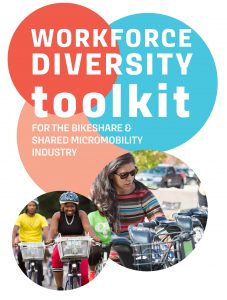NABSA Releases Diversity Toolkit
Created in Cooperation with Better Bike Share Partnership
NABSA has released a new resource, the Workforce Diversity Toolkit for Bikeshare and Shared Micromobility. Created in cooperation with the Better Bike Share Partnership, the toolkit includes case studies of best practices from the industry, questions for self-evaluation, and further resources.
With this toolkit, NABSA has hoped to call attention to the issue of workforce diversity, feature the leading work that organizations in our industry are already doing to meet this goal, and most of all help organizations take the necessary first steps toward building a more diverse industry at all levels of leadership and operations.
 “We are really proud of the hard work so many in the industry are doing to further equity and diversity goals,” said Samantha Herr, NABSA Executive Director. “We need to ensure as an industry that not only are our service programs equitable, our workforce is diverse and reflective of the communities in which we serve.”
“We are really proud of the hard work so many in the industry are doing to further equity and diversity goals,” said Samantha Herr, NABSA Executive Director. “We need to ensure as an industry that not only are our service programs equitable, our workforce is diverse and reflective of the communities in which we serve.”
Equity has been a core value of the North American Bikeshare Association (NABSA) and its members since NABSA’s formation in 2014, both in providing services and internally-focused such as staffing. NABSA has maintained through its Code of Conduct that “NABSA will promote an inclusive culture that encourages, supports, and celebrates the diverse voices of its staff, members and the communities they serve.” This report supports building a diverse workforce reflective of those communities.
Through knowledge-sharing efforts and a partnership with the Better Bike Share Partnership, NABSA has worked to serve our members in this way over the past five years. Our shared goal has been to assist our members in building an industry that is equitable in both internal and external practices.
“Representation is important, and should be reflected at ALL levels including leadership and decision making,” said Waffiyyah Murray, Better Bike Share Partnership Program Manager. “I hope this toolkit will serve as a starting point for leaders in the industry to prioritize a diverse and inclusive workforce that is innovative and representative of those we serve.”
Visit the Workforce Diversity Toolkit online resource to read the full report, download the self-evaluation worksheet, or find links to more resources.
